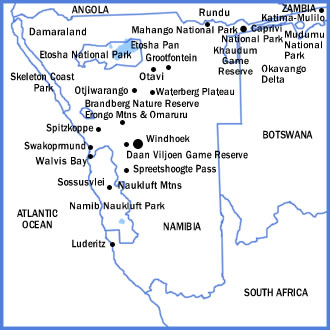ABOUT NAMIBIA BIRDING

AFRICA
NAMIBIA
| # Species: | 664 |
| # Excl Vagrants: | 611 |
| # Endemics: | 1 |
| # Near Endemics: | 30 |
 Most people think of the Namib Desert when they think of Namibia. However, though Namibia is a quite arid country, there is much more to it than the Namib. Birding in Namibia can be quite spectacular, with over 600 species regularly recorded including 2 true endemic and 29 near endemic bird species. In addition, the game parks, including Etosha National Park and Bwabwata National Park offer excellent game viewing emblematic of unspoiled wild Africa. In addition, Namibia has the most stable and progressive government in Africa, has a strong anti-poaching operation, and is very supportive of conservation and environmental policies. It is the only country in the world where big game animals wonder freely outside national parks and preserves. Below is a summary of birding opportunities in Namibia broken down by region.
Most people think of the Namib Desert when they think of Namibia. However, though Namibia is a quite arid country, there is much more to it than the Namib. Birding in Namibia can be quite spectacular, with over 600 species regularly recorded including 2 true endemic and 29 near endemic bird species. In addition, the game parks, including Etosha National Park and Bwabwata National Park offer excellent game viewing emblematic of unspoiled wild Africa. In addition, Namibia has the most stable and progressive government in Africa, has a strong anti-poaching operation, and is very supportive of conservation and environmental policies. It is the only country in the world where big game animals wonder freely outside national parks and preserves. Below is a summary of birding opportunities in Namibia broken down by region.
Central Plateau
Visitors to Namibia typically arrive by air in the capital city of Windhoek, located on the central plateau of the country. Windhoek is the largest city in the country and is quite metropolitan, but there are excellent birding areas nearby. Very close to Windhoek is Avis Dam, located inside the city. On weekends this area can be quite crowded during the day, but there are some good trails through dry scrub habitat where a number of target birds such as Rockrunner and various water birds can be seen. About 25km west of Windhoek is Daan Viljoen Game Reserve. This reserve offers excellent savanna birding as well as game viewing. Large predators are absent but numerous game animals are present. Specialties of the reserve include the near endemic Monteiro's Hornbill, White-tailed Shrike, and Carp's Tit, all of which can be seen there as well as other locales in Namibia. Farther north is the massif of Waterberg Plateau, situated about 300km north of Windhoek and often missed on birding tours. The 200m high plateau is often missed on birding tours because it's somewhat out of the way, but it has its attractions. A number of trails as well as roads provide access through the grasslands and broadleaf forests. Birds of special interest include the Orange River Francolin, which is only occasionally seen, the near endemic Hartlaub's Francolin, the globally vulnerable Blue Crane, and the near endemic Damara Red-billed Hornbill, Rosy-faced Lovebird, Rñppell's Parrot, Rockrunner, and Rufous-winged Cisticola. It's also the only place in Namibia where Booted Eagles nest. In addition, the Waterberg area offers very good game viewing with notable species including White Rhinoceros, Sable Antelope, and Roan Antelope, all introduced to the area.
Namib Desert
The Namib Desert is one of the driest places on earth. Despite that fact, it is home to a diversity of specialized animal life, everything from black and white beetles that use their body color for temperature regulation to mammals that live in somewhat less dry fringes of the desert such as Bat-eared Fox, Yellow Mongoose, Aardwolf, and Aardvark, to specialty birds such as the endemic Dune Lark, near endemic Rũppell's Bustard, Monteiro's Hornbill, and Kopje Warbler, range-restricted desert specialists such as Black-eared Sparrow-Lark and Karoo Thrush. In addition to animal life, the Namib offers spectacular photographic opportunities among the ever shifting dunes, especially near sunset and sunrise.
Coastal Mountains
A number of mountain ranges are found near or along the coast. Near the Namib Desert but just inland are the Naukluft Mountains, an arid treeless area just east of the Namib itself. The Naukluft range is now part of the Namib-Naukluft National Park and is a stronghold for Hartmann's Mountain Zebra, a subspecies of Mountain Zebra. These zebras are adept climbers among the mountain ridges that they call home and are a target mammal for many visitors to Namibia. Notable birds include Common Scimitar-bill and Monteiro's Hornbill. En route to the Naukluft Mountains from Windhoek is a high pass, Spreetshoogte Pass, well known among birders as an important birding stop. Target species in the pass and the surrounding desert include Rosy-faced Lovebird, White-tailed Shrike, Gray's Lark, Karoo Long-billed Lark, Pink-billed Lark, Kopje Warbler, Karoo Scrub-Robin, and Herero Chat. Farther north along the coast are the Erongo Mountains near the town of Omaruru. This mountain range is also quite barren and tree-less, but a suitable lodge there allows overnight stays and the birding has its attractions. Because the lodge is somewhat expensive, it's also possible to stay at more economical accommodations in Omaruru. Notable birds of the Erongo Mountains include Orange River Francolin, Hartlaub's Francolin, Rũppell's Bustard, Damara Red-billed Hornbill, White-tailed Shrike, Karoo Long-billed Lark, and Herero Chat. In the lower elevation semi-desert around Omararu birds such as Red-billed Francolin, Swallow-tailed Bee-eater, Rufous-crowned Roller, Gray-backed Sparrow-Lark, and Cape Bunting can be found. En route to Omararu from Walvis Bay, a coastal town on the coast, is an important birding spot known as Spitzkoppe, a group of bald pointed mountain peaks in the desert. A number of near endemics already mentioned above can be seen there along with additional species such as Gray's Lark, Sclater's Lark and Gray Tit.
Coastal Area
The coastal area around Walvis Bay and Swakopmund is notable especially for seabirds and aquatic birds. A pelagic trip out into the bay is highly worthwhile and offers chances to see pelagics such as White-chinned Petrel, Cape Gannet, and Brown Skua. Also present along the coast, around the few freshwater lagoons, and at the Swakopmund Salt Refinery are large populations of Cape Cormorant, Greater and Lesser Flamingos, ducks, and migratory wading birds. The gravel plains north of Swakopmund are one of the best places to find the near endemic Gray's Lark and are also good for Tractrac Chat.
Northern Plains
In northern Namibia is Etosha National Park, an area of semi-arid savanna and an excellent place for both birding and game viewing. Most visitors go to Etosha in dry season for game viewing, but birding is best during "rainy" season. The most prominent feature of Etosha is the pan, a dry barren plain that becomes inundated during years of significant rains. During those years the pan attracts large numbers of aquatic birds. Important birding areas in Etosha are Fisher's Pan, good for aquatic birds and storks when wet, Namutoni Camp waterhole, Bloubokkie Draai, which is the best place to see Black-faced Babbler, Andoni Plains, a savanna area that is excellent for larks, the open flats of Springfontein, Etosha Lookout in wet years, Halali Camp, where the wooded knoll behind the waterhole attracts Namib specialties, Okaukuego Camp where a large Social Weaver colony attracts Pygmy Falcon and the waterhole attracts numerous seedeaters, and the far western section, which is closed to the general public but is accessible through licensed tour operators and is a good place for specialties such as Hartlaub's Francolin, Monteiro's Hornbill, Rũppell's Parrot White-tailed Shrike, Rockrunner, Violet Wood-Hoopoe, andBare-cheeked Babbler.
Carpivi Strip
In the far northease of Namibia is a narrow strip of land between Angola and Botswana known as Caprivi Strip. Located there is Bwabwata National Park, which is an amalgamation of the Mahango and Caprivi Game Reserves. This region offers some of the best birding in Namibia with about 430 species recorded. The Bwabwata area encompasses lush flood plains and wetlands around the Kavango and Kwango Rivers along with open savanna and savanna woodlands. Boat trips are the best way to see much of the wildlife and birds of the wetlands. A number of Angolan and East African birds reach the southern-most extent of their ranges in the Caprivi area, making the border areas around and between the border towns of Rundu and Katima-Mulilo especially good for birding.
WHY GO BIRDING IN NAMIBIA
Namibia is an arid country but it's certainly not devoid of attractions. Over 600 species of birds are found there including one endemic species, the Dune Lark and nearly 30 near-endemics. In addition to birding, Namibia offers excellent game viewing as well as some extraordindary opportunities for photography in the Namib Desert. The variety of arid country birds and mammals along with its proximity to the water wonderland of the Okavango Delta in neighboring Botswana and nearby Victoria Falls in neighboring Zambia makes Namibia a most intriguing country to explore.
WHEN TO VISIT NAMIBIA
General tourists typically visit Namibia during the dry season from April to November, especially during the driest months of September and October when game viewing is best because game animals congregate around permanent water in Etosha and other game parks. April and May are often quite pleasant because the air is fresh from the recent rains and there is still greenery in the landscape. From June to August the nights can be quite cold as it's austral winter during that time. The coolest months are during dry season, though temperatures vary depending on location, with the Caprivi area being more subtropical and the central plateaus being cooler than the coast. During dry season birds are in non-breeding plumage and Palearctic migrants are mostly absent.
The ideal time for birding in Namibia is during wet season from December-March when birds are actively breeding. The downside is that the rains, though not extensive in most years, create conditions that are physically less pleasant since mosquitos and other insects are most abundant at that time. The wet season is also the hottest time of year in Namibia so visitors during that time must be willing to tolerate higher temperatures in an already quite hot country. A good compromise is April when birds are finishing up with breeding while temperatures are cooler and insect problems have abated.
OTHER COUNTRIES
IN AFRICA
BIRDING LOCALES





